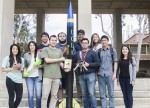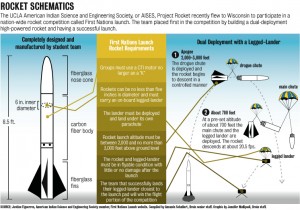Flashing lights and high-pitched sirens went off as dozens of students erupted into cheers. The rocket’s landing device had made it home and their months of hard work paid off.
The eight-and-a-half foot tall rocket was built by members of the American Indian Science and Engineering Society Rocket Project, a UCLA student-run program that launched three years ago.
The growing team flew to Milwaukee earlier this quarter to compete in the First Nations AISES and Tribal Rocket Launch Competition, taking home the top prize for the first time.
AISES Rocket Project co-directors Daniel Calderon and Dylan Rodarte, both fourth-year mechanical engineering students, started recruiting for the team during the first two weeks of fall quarter.
The club met weekly in Boelter Hall and both Calderon and Rodarte taught the engineering students the fundamentals of rocketry.
“We taught them things that are very basic, but may not be very intuitive,” Rodarte said. For example, he explained, not every student knows that when designing a rocket, you have to make sure it flies into the wind instead of with it.
Once the entire team chose the best rocket design, the students were able to transform their idea into a tangible project. The students drove to Calderon’s dad’s machine shop in Riverside for three Saturdays and spent about 12 hours machining.
At one point in the project, Rodarte was operating a drill while a younger team member held onto the rocket part. Rodarte lost control of the drill and cut his right middle finger.
“I can honestly say blood went into building this rocket,” Rodarte said, laughing.
Justine Figuerres, a second-year electrical engineering student, said the most difficult part of the project was trusting herself and the work she had done.
“Things have to be extremely precise to the tenth of a centimeter, to the tenth of a millimeter even,” she said. “I could mess up and it would be the difference between our rocket flying successfully and our rocket just plummeting like a missile.”
The rocket project also works on different communityprograms, such as inviting K-12 students from local schools and teaching them about science.
To get the younger students excited about chemistry and physics, the project works with the students on different science experiments, such as making ice cream with liquid nitrogen or making silly putty out of crafting glue.
The project also goes to John Adams Middle School during the week to tutor a group of about 20 students. The AISES Rocket Project works in conjunction with UCLA’s Latino and black engineering campus organizations respectively – the Society of Hispanic Professional Engineers and the National Society of Black Engineers.
The most memorable part of the trip for second-year electrical engineering student Kari Garcia was painting the rocket the night before the launch in the hotel parking lot.
“It was really cold and we were all bundled up not used to the cold snow,” Garcia said. She added that she used what she had learned in her engineering classes to construct the electrical circuitry of the lander’s alarm system.
“I haven’t taken any classes on rocketry. Everything I learned about rockets was from just doing this project,” Calderon said, adding that the team plans to expand the makeup of the group by inviting students of all academic departments for next year’s project.
The team aimed to land their rocket as close to the launch site as possible, which successfully set off the lights and alarm of the the rocket’s landing device upon reaching the ground, said Rodolfo Barranco, a second-year aerospace engineering student.
“When our rocket landed, it did all those things perfectly – it was gorgeous,” he said with a smile.
Next year, the team will take on the Mach 1 challenge – building a rocket that can break the speed of sound.
Though Calderon is graduating this year and Rodarte is staying for a fifth year, both students plan to step down as co-directors and focus on teaching the younger students enough information on building rockets to help make the team self-sufficient for coming years.

